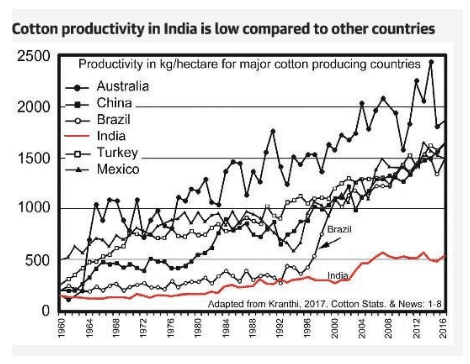UPSC Articles
Agriculture & Environment
Topic: General Studies 3:
- Major crops-cropping patterns in various parts of the country,
- Issues related to direct and indirect farm subsidies and minimum support prices;
- Awareness in the fields of Bio-technology
- Conservation, environmental pollution and degradation, environmental impact assessment

Daily Current Affairs IAS | UPSC Prelims and Mains Exam – 23rd January 2020
India’s Cotton Story
India’s Cotton Productivity is low in comparison to other major cotton producing nations in spite of India expected to be world’s largest cotton producer this year surpassing China
Genetically Modified (GM) pest resistant Bt cotton hybrids have captured the Indian market since their introduction in 2002. These now cover over 95% of the area under cotton, with the seeds produced entirely by the private sector.
India’s cotton production in 2019 is projected as the highest ever: 354 lakh bales. This threefold increase in cotton production during past two decades is used by proponent of GM crops to extend the technology to other crops as well
India is the only country that grows cotton as hybrids and the first to develop hybrid cotton back in 1970
Difference between hybrids and varieties
| Varieties (Used in Brazil) | Hybrids (Used in India since 1970s) |
| Varieties are those for which seeds are produced by self-fertilization. | Hybrids are made by crossing two parent strains having different genetic characters.
These plants have more biomass than both parents, and capacity for greater yields |
| Varieties can be propagated over successive generations by collecting seeds from one planting and using them for the next planting; | Hybrid seeds have to be remade for each planting by crossing the parents. So for hybrids, farmers must purchase seed for each planting. Increased dependence on seed companies |
| High Density Planting (HDP) Methodology: These varieties are planted at high density (5 kg seeds/acre) | Hybrids are planted at ten-fold lower density (0.5 kg seeds/acre). |
| They are compact and short duration. | hybrids in India are bushy and long duration |
| Lower boll production by compact varieties (5-10 bolls per plant) – compensated by high density | High boll production (20-100 bolls/plant) |
| Cotton is a dryland crop; therefore, shorter duration variety has a major advantage as it reduces dependence on irrigation | 65% of area under cotton in India is rain-fed. Farmers with insufficient access to groundwater in these areas are entirely dependent on rain. Thus risk associated with hybrid cotton cultivation is higher due to unpredictability of rains |
| Low requirement of fertilizer (100 kg/ha for varieties) | High fertilizer requirement: 200 kg/ha for hybrids |
| lLess vulnerability to damage from insect pests due to a shorter field duration. | High vulnerability to damage from insect pests due to a longer field duration. |
| Low water requirement | High water requirement |
| Low cost of seeds | High Cost of Hybrid seeds. Increased yield from a hybrid is supposed to justify the high price |
Hybrid model is inferior to the HDP model being used in other countries on three important counts: much lower productivity; higher input costs; and increased risk particularly for low resource farmers in rain-fed areas.
The steep increase in productivity for Brazil, from 400 to 1,000 kg/hectare lint between 1994 and 2000 coincides with the large-scale shift to a non-GM compact variety.
Why HDP model not adopted despite having advantages for India?
- During First Phase (From 1980 to 2002): Hybrids were promoted at the cost of Compact varieties. This was primarily due to weakness of agricultural research establishment who failed to identify the benefits of compact varieties
- Second phase (2002 onwards): During introduction of GM Bt hybrid seeds. However, the scope of evaluation by the GM regulatory process in India was narrow and did not take into account on the form in which it would be deployed (hybrids versus varieties)
Consequently, commercial Bt hybrids have completely taken over the market, accompanied by withdrawal of public sector cotton seed production.
The Indian cotton farmer today is left with little choice but to use Bt hybrid seed produced by private seed companies. The current annual value of cotton seed used for planting is about ₹2,500 crore, and that of lint cotton produced is ₹68,000 crore.
It is likely that production levels could have been much higher, with considerably lower risk and input costs, had compact varieties been developed and used in India, especially given the agricultural distress faced in India.
Conclusion
- We must be clear that the outcome of using a technology such as Bt is determined by the context in which it is deployed, and not just by the technology itself. Brazil (until 2012) and Turkey (up to the present) have achieved high productivity without the use of GM cotton by using alternative pest-management approaches.
- There is a need for better consultation in policy, be it agriculture as a whole or crop-wise. Socioeconomic and need-based considerations should be a part of GMO regulatory process in India.
Connecting the Dots
- Bt Brinjal Controversy
- Genetic Engineering in other fields – Medicines, disease prevention and cure.














